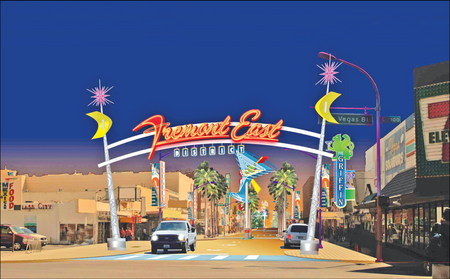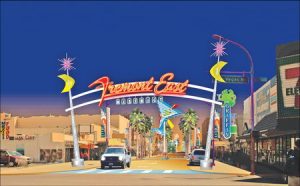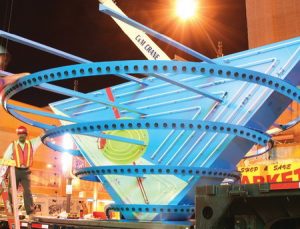Electric Signs
Fluoresco Does Fremont
Architectural signage kicks up a Las Vegas redevelopment project.
Published
17 years agoon

Fluoresco Lighting & Signs (Tucson, AZ) helped turn on the Fremont East entertainment district in Las Vegas and ensured what happens on this historic street stays illuminated in visitors’ memories forever.
Launched in January and completed in August, the $5.5 million streetscape revitalizes three blocks of Fremont Street, whose name honors the late explorer and presidential candidate John C. Fremont (he camped at Las Vegas Springs in 1844). The two-block entertainment district comprises eastbound Las Vegas Blvd. to Eighth St. and a portion of Ogden and Carson avenues, which are one block north and south of Fremont, respectively.
The district, a public-private partnership between the city of Las Vegas, Fremont East property owners and the Nevada Dept. of Transportation, extends immediately east of the five-block Fremont Street Experience. Other improvements include pedestrian-friendly streets with wider sidewalks, more lightpoles and upgraded landscaping.
Spanning gateways on the district’s east and west ends beckon visitors into the neighborhood. Subsequently, neon streetscapes – a martini glass, a vintage “Viva Vegas” sign, and a showgirl with a rotating ruby slipper – dominate the scene as district focal points. Selbert Perkins Design’s (SPD), Playa del Rey, CA-based office developed the environmental graphics that Fluoresco fabricated.
“The city is capitalizing on popular nostalgia by reviving the glamour of vintage Las Vegas,” Scott D. Adams, director for the city’s Office of Business Development and operations officer for its Redevelopment Agency, said. “City dwellers particularly enjoy Las Vegas’ retro style made famous during the Rat Pack era.
Advertisement“The streetscapes were designed to promote an attractive, walkable experience for both locals and out-of-town patrons,” Adams said. The pedestrian-friendly environment promotes walking to and patronizing not just casinos, but nightclubs, restaurants, entertainment venues and shops.”
Fluoresco’s work proves central to this experience. “The lighting will make people feel safer and add to the entertainment element of the district,” Adams said.
The design perspective
According to John Lutz, who served as SPD’s Fremont East project manager, an initial site survey demonstrated the area’s blight. He said, “This program is part of an economic and infrastructure invest¬ment that will yield a more tourist-friendly, vital neighborhood.”
SPD developed the name and logo for the district and provided the renderings based on consultations with the Las Vegas Redevelopment Agency. For its artwork, SPD used Adobe Illustrator® and Photoshop®, and created construction documents in AutoCAD. In turn, Fluoresco generated preliminary shop drawings and enhanced SPD’s material specs and construction drawings, Mark Mackin, Fluoresco’s technical-support specialist, said.
Because Fremont East hosts only one casino (located at the El Cortez motel), Selbert Perkins eschewed gambling-related iconography in favor of nightlife symbols. For inspi¬ration, Lutz visited Young Electric Sign Co.’s (YESCO) “boneyard” of vintage signage.
“We noticed that signs from this era were literally larger than life and awe inspiring, and built at a super scale,” Lutz said. “We wanted the street elements to become Vegas-specific landmarks. Only in Vegas can you see these over-the-top signs close enough to understand the details and craftsmanship.”
AdvertisementFrom this visit, he gleaned several “Googie” architectural elements (Googie-vintage architectural style features sharp curves, geometric shapes, bright lighting and futuristic imagery), such as the gateway sign’s custom typeface and chevron-shaped features.
“We imagined having them built as they would have been in the 1950s, but incorporating 21st-century technology,” he said. “We specified LEDs to resemble incan¬descents while delivering contemporary ease of maintenance and energy savings.”
Also, Lutz said they chose the martini glass, dancing girl and other icons because they wished to emphasize “nonverbal communication” with their design. In some cases, they adjusted the types of LED modules and programming systems to fulfill Fluoresco’s fabrication process. However, he said, “One year after we created the initial renderings, our firm’s work looks virtually identical to the finished product.”
Neon nostalgia
Las Vegas Paving was awarded the general contractors’ job to develop Fremont East and subsequently chose Fluoresco to fabricate the architectural elements. The two companies worked closely to minimize the construction’s impact on the area.
Fluoresco’s contract called for building the environmental graphics for the two gateways that span Fremont Street; the four, large-scale median streetscapes, each with identifying, cast-bronze plaques; six, district-identity banners attached to existing light poles (inspired by the Mint Hotel); 11 custom street signs; and 18 cast-bronze crosswalk medallions. Fluoresco also dug the footing holes, installed the concrete footings, and bolted down and wired the signs. An electrical contractor brought in the primary electrical service.
AdvertisementAs Fluoresco created shop drawings, SPD analyzed their design intent and overall construction methods; city engineer Rusty Coleman determined structural integrity, electrical wiring and serviceability; and Las Vegas Paving reviewed for foundations, primary electrical runs and scheduling.
Fremont pathfinders
Each of the identical, Space Age-style gateway signs comprises two laser-etched, stainless-steel-clad poles that slightly splay outwards toward, respectively, the north and south sides of Fremont. The 34-ft.-high poles, which are centered 44 ft. across the street, taper from 18 to 7¼-in. Fluoresco bolted them to decorative, 24-in.-wide, steel-banded, concrete caissons.
Stretching between these poles are two, symmetric, rectangular, aluminum tubes, that Fluoresco painstakingly rolled into a radius. Vertical, 3-in.-diameter, round pipes connect these tubes to create a truss; these support the retro-styled gateway sign. Red script letters complement multiple strokes of exposed, yellow neon. Centered beneath this is the sans-serif “District” with red neon lit behind red acrylic faces.
Above the trusses on each side, Fluoresco installed stylized yellow arrows that resemble crescent moons or boomerangs. Each incorporates a single stroke of exposed neon. Above these, at the top of each pole, are purple starbursts (also known as “sputniks”) with one purple, RGB LED module from Tokistar (Toronto, ON, Canada) at the tip of each tine. Fluoresco fabricated all neon inhouse. For these elements, we implemented a 277V power system.
These sputniks, reminiscent of the iconic “Welcome to Fabulous Las Vegas” sign designed by Betty Willis (see ST, April 2005, page 140) appear in the “Viva Vegas” sign.
Integrated with the starbursts, the words flow with flashing neon as they cycle and read “Fremont,” “East” and “District.” The stylized arrows flash alternately to text.
The 3-D sputniks had to fulfill the designers’ intent, but also be easily accessible for city-maintenance service. Using SolidWorks 3-D CAD software, Fluoresco developed a multi-faceted, sphere-like center hub into which three- and four-sided tines could bolt.
After having developed them in 3D, Fluoresco converted all of the pieces to flat shapes, which it routed out of flat aluminum sheets and plates, and formed, welded and bolted together. All of these pieces have hollow centers (with some structural baffles), which allows the wiring and attachment of the LED diodes.
Read Part Two

SPONSORED VIDEO
Introducing the Sign Industry Podcast
The Sign Industry Podcast is a platform for every sign person out there — from the old-timers who bent neon and hand-lettered boats to those venturing into new technologies — we want to get their stories out for everyone to hear. Come join us and listen to stories, learn tricks or techniques, and get insights of what’s to come. We are the world’s second oldest profession. The folks who started the world’s oldest profession needed a sign.
You may like

4 of the Most Fun Sign Projects in Years

Sign Pro’s Phrase Coaches Customers with Bad Ideas

2024 Sign Contest Open for Submission
Subscribe

Bulletins
Get the most important news and business ideas from Signs of the Times magazine's news bulletin.
Most Popular
-

 Paula Fargo2 weeks ago
Paula Fargo2 weeks ago5 Reasons to Sell a Sign Company Plus 6 Options
-

 Real Deal1 week ago
Real Deal1 week agoA Woman Sign Company Owner Confronts a Sexist Wholesaler
-

 Photo Gallery2 weeks ago
Photo Gallery2 weeks ago21 Larry Albright Plasma Globes, Crackle Tubes and More
-

 Projects1 week ago
Projects1 week agoGraphics Turn an Eyesore Cooler Into a Showpiece Promo in Historic Plaza
-

 Business Management1 week ago
Business Management1 week ago3 Things Print Pros Must Do to Build Stronger Relationships in the Interiors Market
-

 News15 hours ago
News15 hours ago2024 Sign Contest Open for Submission
-

 News1 week ago
News1 week agoPattison ID New Name of Five Companies
-

 Manager's To Do5 days ago
Manager's To Do5 days agoMarketing Signs to Schools, Tradeshow and Quote Follow-up Make May’s List















